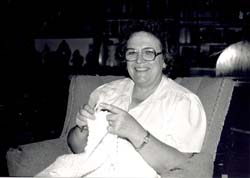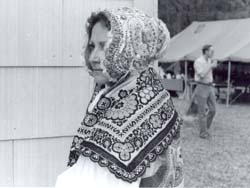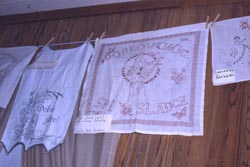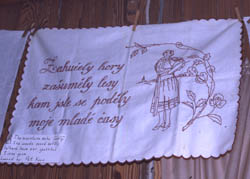Textile Uses in the Homes of Central Louisiana Czechs
By Rosie A. Walker
Most Czechs who immigrated to America settled on farms in the Midwestern states and Texas or the mining communities of the northeast. Some, who were skilled craftsmen, flocked to the major cities of the north where ethnic towns within the city flourished. To find a better life for the immigrants among their family and friends, organizations such as the Bohemian Colonization Club sought out large tracts of land for the establishment of Czech colonies where Czechs could live together and preserve their language and culture.
In 1912, after a year of searching for a suitable location, the Colonization Club reported a large area of land in central Louisiana available for low cost and having an ideal climate for farming. The Louisiana Investment Securities Company took over the project purchasing cut over land the lumber companies were willing to unload at 50 cents an acre and then resold it to the 200 or more subscribers of the Bohemian Colonization Club for $15 to $18 an acre. The land was on the northeast of the Red River and was not of the same alluvial quality of the Bayou Rapides area thus increasing the amount of work the colonist had to put into their farms to yield a profit if it was at all possible.
The Czechs brought with them an intense love of the land, enthusiasm for scientific farming, and a tremendous community spirit. They subscribed to many Czech papers and magazines, but the one relied upon most heavily was the Hospodar. This farm journal provided agricultural information, seed and crop reports, stories, letters, and cultural articles as well as tips for the homemaker.
Today you will still find the evidence of the Czech colonies in Libuse, named after a legendary queen, and Kolin, named after a town in the old country and a song by that same name. The farms are almost all gone except for the large barns that still stand as a tribute to the agricultural efforts of these pioneers. The cemeteries of the two communities give record of the many people who contributed to the 75 year history of the communities. The homes still contain many of the textile crafts of the original colonists and many other utilitarian and decorative articles that continue to be crafted in the rich tradition that was brought from central Europe.
The Czech people come from a tradition rich in the use of textiles in the home. The farming people had a wealth of peasant traditions as many of them come from small isolated villages like Kolovic in the Domazlice Okres (county) better known as the Chodsky region near the Sumava Mountains. The traditions of craftsmanship were retained upon coming to America. The colonists settled in rural or ethnic centers where they fell back on the memory of what they had in the home of their birth so they could create a friendly loving environment for themselves in their new homes.

Most of the women had the skills of embroidering, crocheting, and sewing but did not do much of this handwork during the early colonization period between 1914 through the late 1920s because most of their time was absorbed in outdoor labor so the family could survive. Some fine needlework done before engaging the pioneering effort was treasured and used to decorate the home. However in the late 1920s and 1930s more time became available as some of the ladies began to retire from manual labor because of age and health reasons and were being replaced in the field by the younger generation. Being trained never to be idle, they quickly turned to the earlier skills and talents that had been put aside. The grandmothers were soon teaching their grandchildren the art of embroidery and crochet along with sewing just about every item a busy household needed. Also, the need to refurbish the home as inexpensively as possible became necessary as economic depression made it virtually impossible for the purchasing of items for the home.
Textiles were used to embellish the home. Heavyweight cloth was used to make shoe bags that could hang in the closet, garment bags, laundry bags, trunk and furniture covers, featherbed covers, and book sacks. Finer weave cloth was used for pillowcases, sheets, dresses shirts, gowns, undergarments, curtains, and wall hangings. Crochet pieces decorated kitchen shelves, book cabinets, tables, and were used to add ornamental touches to almost every type of feminine clothing and decorative scarves.

Many utilitarian objects fashioned from purchased or found textiles served the Czech home for many years. The found textiles were the beautifully printed feed and seed sacks the farmers' wives collected, swapped, and used to make dresses and shirts for their family. The unbleached cotton sacks that were used for flour, fertilizer, salt, and sugar in quantities of 50 or 100 pounds became dish towels, pillow cases, featherbed covers, sheets, curtains, and diapers. The cotton string that bound the sacks was unraveled and rolled into large balls to be used for crochet thread especially good for bedspreads, tablecloths, doilies, and sofa head and arm rests. The cotton string was very durable and improved with continual washing.
Quilts were made utilizing scraps and remnants. The crazy quilt and patchwork quilt were fashioned in such a way as not to waste even the most unusual shaped fabric. The pieces were joined in an artistic fashion with the use of a variety of embroidery stitches.
The folk artists set their own rules and did not allow themselves to be greatly influenced by trends, fads, and fashions of academic arts. The late Marie Wittera Brousek whose work will be on exhibit at the Louisiana Folklife Festival at the Czech crafts booth, was unique in her design, individuality of style and multicolored embroidery work when the accepted fashion was usually monochrome in nature whether all red or blue. The wall hangings and curtains that have been preserved contain hand drawn angels and cherubs, a wide assortment of baskets overflowing with colorful flowers, butterflies, birds, and her own style of lettering with a uniquely reversed "N" on several of her pieces. After studying her pattern books, which was nothing more than a scrapbook of cut out pictures of crocheted designs, she would create her own design adapting it for her particular need. She did this for over fifty years depending on sight only as she did not know how to read a pattern book. Several hundred of her pieces and patterns can still be found today in the community and as far away as Nebraska and Iowa.
The home of the Czech family employed the use of textiles in almost very aspect of daily life. Embroidered wall hangings called the "Kitchen Helper" were done in a variety of stitches showing the tradition of mastery over a wide diversity of stitches characteristic of the Czechoslovaks. The designs usually contained a domestic scene with a proverb or word of advice. The predilection for bright color is noticed in the use of reds and blues. It is interesting to note that the same design is found in different homes with only slight modifications and a change in color and/or border trim. The original work was probably purchased already stamped on linen during the early days of the Czech colonization of central Louisiana. The stamped cloth was obtained through a catalogue from the Czech importer, Pancers of Chicago. The completed work was probably admired by family and friends and copied by hand on lesser quality cloth and adopted for use in their own homes. The cloths served very useful purposes. They hung above the kitchen table or over the stove area and received food splatters as the busy cook prepared her meals, baked kolaches, or preserved fruits and vegetables. After becoming soiled the cloth could be easily washed and ironed. The cloth not only kept the wall clean it also decorated the room with a colorful picture and a word of welcome or advice.
The saying and picture varied in theme and quality of workmanship. A young man and lady in an embrace may remind the viewer of the loyalty of love with some appropriate words stitched into the design. A popular design reminding the Czech of his two great loves, land and music, was entitled "Kde Domov Muj". The title "Where Is My Home" was also the title of the then newly created Czechoslovakian national anthem. The picture shows the girl seated on a horse playing the violin (music) while the man follows behind guiding the plow over the field (land) with the home in the background. This was a sentimental piece which truly summed up the Czech feeling so it is not surprising that three versions of this wall hanging still exist today.
Decorative towels that hung over the wash basin gave the greeting 'Dobre Jitro' (Good Morning). Pillowcases and bed curtains commended one to sleep sweetly. Popular kitchen cloths were more positive in the advice they gave. They contained proverbs familiar to the Czechs such as "Without Work You Cannot Eat Kolace", or "Where the Czech Housekeeper Cooks There is Good Living", and "Good Food and Good Drink Will Preserve the Quality of your Life".
The wall hangings are finished according to the talents of the makers. Some have simple hems or colored bands and rick-rack borders. Others are finished in button-hole embroidery stitches or with a fine satin stitch.
It is through the efforts of Mary Frances Hazmark that a collection of unique wall hangings will be available for display at the Louisiana Folklife Festival. Mrs. Hazmark learned to work with textiles from her mother as a child, but has developed her skills on her own to be used in her craft work. She and her daughter design and make soft dolls dressed in the Czech costumes along with many other fabric toys. Mrs. Hazmark has photographed, translated, and made copies of the sayings and pictures from t he Czech wall hangings she has located and recently has made transfer patterns and embroidery kits available for others so that this creative art from would not be lost or forgotten.
Sewing dresses and shirts for the family had always been a part of life for many of the Czech homemakers. Today, that skill and talent is used in the making of the colorful costumes that are worn by the Czech dancers and singers. The colorful costumes are richly decorated with varying degrees of embroidered designs and trimmed with fine lace, colorful ribbons, and crocheted edges aprons. The costumes which have been handmade by the wearers or older members of the community resemble the regional folk costumes of their central European ancestors.
Mrs. Mildred Tuma Sasser studied a costume her aunt brought with her from Czechoslovakia for the pattern she used in making the richly decorated aprons, blouses, skirts, and vests that adorn her many children, grandchildren, and great-grandchildren. An especially unique feature of the costumes Mrs. Sasser makes are the crocheted aprons for the girls and the beaded designs that decorate the boys' vests. She also makes costumes with colorful printed skirts other than the basic red skirt worn by the dance group. She is quick to point out that the colorful skirt is more in keeping with the traditional costume worn by her ancestors in their particular region in the old country.
Mrs. Zdenka Safarik also copied her design from a costume sent to her by her family. The costume was saved from destruction during World War II by being buried in glass containers in the ground. The costume or 'Kroj' as Miss Z refers to it is made in the style of her ancestors with wide flowing sleeves on the men's shirts decorated with cut-out designs lined with colored cloth and edged with a black button-hole stitch. The women have a large lace ruffle around the neck also trimmed in black. The costumes form a beautiful swirl of color as visitors to the Louisiana Folklife Festival will see as Mrs. Safarik's son and daughters, their husbands and wives, children, and grandchildren dance the Beseda, a Czech folk dance. Miss Z tells of the importance of the embroidery on the aprons. Each generation portrays their story by carefully selected designs and it is added to by succeeding generations as the costume is passed from mother to daughter. As one row of embroidered designs builds upon another row, the family's history unfolds. On exhibit will be the original costume that was preserved from destruction and served as a pattern for the Safarik family.




